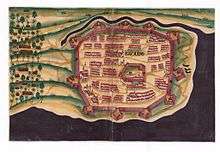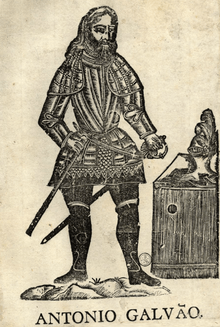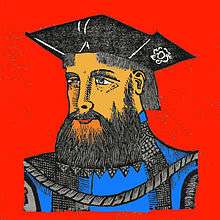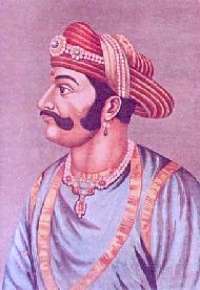Battle of Vasai
| Battle of Baçaim | |||||||
|---|---|---|---|---|---|---|---|
| |||||||
| Belligerents | |||||||
|
| |||||||
| Commanders and leaders | |||||||
|
|
| ||||||
| Strength | |||||||
| 100,000[1] | |||||||
| Casualties and losses | |||||||
| Unknown Wounded[2] |
800 killed Unknown Wounded[3] | ||||||
The Battle of Vasai was fought between the Marathas and the Portuguese rulers of Vasai (Portuguese, Baçaim; English, Bassein), a town lying near Mumbai (Bombay) in the present-day state of Maharashtra, India. The Marathas were led by Chimaji Appa, a brother of Peshwa Baji Rao I. Maratha victory in this war was a major achievement of Baji Rao I's reign.[4]
Background
The Baçaim (now known as Vasai) region ruled by Portuguese in not just Baçaim but included areas far away as Bombay, Thane, Kalyan, Chaul and Revdanda. It is located about 50 Kilometers North of Bombay, on the Arabian Sea. Baçaim, was important trading center, its sources of wealth and trade were horses, fish, salt, timber, basalt and granite and shipbuilding. It was a significant trading center long before the Portuguese arrived. (Ancient Sopara was an important port in trade with the Arabs and Greeks, Romans and Persians.). It was also a wealthy agricultural region with rice, betel nut, cotton, and sugar-cane as some of the crops.[5]
16th Century
In 1530 Antonio de Sylveria burnt the city of Bassein and continued the burning and looting to nearby Bombay, when the King of Thana surrendered islands of Mahim and Bombay. Subsequently, the towns of Thana, Bandora, Mahim and Mombaim (Bombay) were brought under Portuguese control.[6] In 1531, António de Saldanha while returning from Gujarat to Goa, set fire to Bassein again - to punish Bahadur Shah of Gujrat for not ceding Diu.

In 1533 Diogo (Heytor) de Sylveira, burnt the entire sea coast from Bandora, Thana, city of Bassein and areas up to Surat. Diogo de Sylveira returned to Goa with 4000 slaves and spoils of pillaging.[7] For the Portuguese, Diu was an important island to protect their trade, which they had to capture. While devising the means to capture Diu, Portuguese General Nano da Cunha, found out that the governor of Diu was Malik Ayaz whose son Malik Tokan was fortifying Bassein with 14,000 men.

Nano da Cunha saw this fortification as a threat. He assembled a fleet of 150 ships with 4000 men and sailed to Bassein. Upon seeing such a formidable naval power, Malik Tokan made overtures of peace to Nano da Cunha. The peace overtures were rejected. Malik Tokan had no option but to fight the Portuguese. The Portuguese landed north of the Bassein and invaded the fortification. Even though the Portuguese were numerically insignificant, they fought with skill and valor killing off most of the enemy soldiers but lost only a handful of their own.[8]

On 23 December 1534, the Sultan of Gujarat, signed a treaty with the Portuguese and ceded Bassein with its dependencies of Salsette, Mombaim (Bombay), Parel, Vadala, Siao (Sion), Vorli (Worli), Mazagao (Mazgao), Thana, Bandra, Mahim, Caranja (Uran).[9] In 1536, Nuno da Cunha appointed his brother-in-law Garcia de Sá as the first Captain/Governor of Bassein. The first corner stone for the Fort was laid by António Galvão. In 1548 the Governorship of Bassein was passed on to Jorge Cabral.[8]

In the second half of 16th century the Portuguese built a new fortress enclosing a whole town with in the fort walls. The fort included 10 bastions, of these nine were named as: Cavallerio, Nossa Senhora dos Remedios, Reis Magos Santiago, São Gonçalo, Madre de Deos, São Joaõ, Elefante, Saõ Pedro, São Paulo and São Sebastião, São Sebastião was also called "Potra Pia" or pious door of Bassein. It was through this bastion that the Marathas would enter to defeat the Portuguese. There were two medieval gateways, one on seaside called Porta do Mar with massive teak gates cased with iron spikes and the other one called Porta da Terra. There were ninety pieces of artillery, 27 of which were made of bronze and seventy mortars, 7 of these mortars were made of bronze. The port was defended by 21 gun boats each carrying 16 to 18 guns. This fort stands till today with the outer shell and ruins of churches.[10]
In 1548, St. Francisco Xavier stopped in Bassein, and a portion of the Bassein population was converted to Christianity. In Salsette island, the Portuguese built 9 churches: Nirmal (1557), Remedi (1557), Sandor (1566), Agashi (1568), Nandakhal (1573), Papdi (1574), Pali (1595), Manickpur (1606), Merces (1606). All these beautiful churches are still used by the Christian community of Vasai. In 1573 alone 1600 people were baptized.[7]
17th Century
.jpg)
As Bassein prospered under the Portuguese, it came to be known as "a Corte do Norte" or "Court of the North", it became a resort to "fidalgos" or noblemen and richest merchants of Portuguese India. Bassein became so famous that a great Portuguese man would be called "Fidalgo ou Cavalheiro de Baçaim" or Nobleman of Bassein.[11] Bassein during the Portuguese period was known for the refinement and wealth and splendor of its buildings, palaces and for the beauty of its churches. This Northern Province, included a territory which extended as far as 100 kilometers along the coast, between Damao (Daman) and Mombaim (Bombay), and in some places extended for 30-50 kilometers inland. It was the most productive Indian area under Portuguese rule.[12]
In 1618 Bassein suffered from a succession of disasters. First it was struck by a disease then on May 15, the city was struck by a deadly hurricane/cyclone. It caused considerable damage to the boats, houses and thousands of the coconut trees were uprooted and flattened. The winds pushed sea water into the city. The monasteries and convents of the Franciscans and Augustinians were ruined. The roofs on three largest churches in the city and both the house and the church of the Jesuits were ripped off and ruined almost beyond repair. This storm was followed by so complete a failure of rains which resulted in near famine conditions. In a few months the situation grew so precarious that parents were openly selling their children to Muslim brokers into slavery rather than to starve them to death. The practice was stopped by the Jesuits, partly by saving from their own scanty allowances partly by gifts from the rich.[13] In 1634, Bassein numbered a population of 400 Portuguese families, 200 Christian Indians families and 1800 slaves (possibly from its African colonies). In 1674, Bassein had 2 colleges, 4 convents and 6 churches.[14]

In 1674, 600 Arab pirates from Muscat landed at Bassein. The fort garrison panicked and was too scared to oppose the pirates outside the fort walls. The pirates plundered all the churches outside of the fort walls and spared no violence and cruelty towards people of Bassein.[15] In 1674, More Pundit stationed himself in Kalyan, and forced the Portuguese to pay him one-fourth of the Bassein revenues. Two years later Shivaji advanced near Saivan.[16] As the Portuguese power waned towards the end of the seventeenth century Bassein suffered considerably. The importance of Bassein was reduced by transfer of neighboring Bombay island to the British in 1665 (It was a wedding dowry from Catherine Braganza of Portugal to Charles the Second of England). The British had coveted and eyed Bombay for many years before it came into their possession under the terms of the marriage treaty. They had ventured to seize it by force in 1626 and had urged the Directors of the East India Company to purchase it in 1652.[17] The intolerance of the Portuguese to other religions seriously hindered the growth of Bassein or Bombay as a prosperous settlement. Their colonization efforts were not successful because they had gradually divided the lands into estates or fiefs, which were granted as rewards to deserving individuals or to religious orders on a system known as “aforamento“ whereby the grantees were bound to furnish military aid to the king of Portugal or where military service was not deemed necessary, to pay a certain rent.[18] The efficiency of the Portuguese administration was weakened by frequent transfers of officers, and by the practice of allowing the great nobles to remain at court and administer their provinces. They soon became a corrupt and luxurious society based upon slave labor. The cruelties of the Inquisition (from 1560) alienated the native population and the union of Portugal with Spain (1580) deprived the Indian settlements of care of the home government. The Portuguese trade monopoly with Europe could henceforth last only so long as no European rival came upon the scene.[19]
18th Century & Maratha Invasion
In 1720, one of the ports of Bassein, Kalyan, was conquered by the Marathas and in 1737, they took possession of Thane including all the forts in Salsette island and the forts of Parsica, Trangipara, Saibana (Present - Saivan, south bank of the Tansa river), Ilha das Vaccas - (Island of Arnala), Manora (Manor), Sabajo (Sambayo/Shabaz near Belapur) - present day Belapur fort) the hills of Santa Cruz and Santa Maria.[20] The only places in the Northern Provinces that now remained with the Portuguese were Chaul (Revdanda), Caranja, Bandra, Versova, Bassein, Mahim, Quelme (Kelve) -(Kelve/Mahim), Sirgão (Present day Shirgao), Dahanu Sao Gens (Sanjan), Asserim (Asheri/Asherigad), Tarapor (Tarapur) and Daman.[21] By 1736 the Portuguese had been at work for 4 years constructing the fortress of Thana, and aside from the long delays, the workers were unpaid and unfed.[22] The people were tired of the oppression, finally invited the Marathas to take possession of the island of Salsette, preferring their rule to the oppression of the Portuguese. These were some of the factors that weakened Bassein and set stage for attack by Marathas.
Siege of Baçaim
The Siege of Baçaim began on 17 February 1739.[23] All the Portuguese outposts around the major fort at Vasai had been taken. Their supply routes from the north and south had been blocked and with the Angres manning the seas, even that route was unreliable . Chimaji Appa arrived at Bhadrapur near Vasai in February 1739. According to a Portuguese account, his forces numbered 40,000 infantry, 25,000 cavalry, and around 4,000 soldiers trained in laying mines. Plus he had 5,000 camels, 50 elephants etc. More joined from Sashti in the following days, putting the total Maratha troops amassed to take Vasai at close to 100,000. The Portuguese, alarmed at this threat, decided to vacate Bandra, Versova and Dongri so as to better defend Vasai. As per orders of the Portuguese Governor, only Vasai, Daman, Diu and Karanja (Uran) were to be defended. These were duly fortified. In March 1739, Manaji Angre attacked Uran and captured it from the Portuguese. This was followed by easy Maratha victories at Bandra, Versova and Dharavi which the Portuguese garrison had vacated. Manaji Angre joined Chimaji Appa at Vasai after this. Thus by April 1739, the noose around Vasai had further tightened.

The capture of Thane and Dharavi meant that even small boats could not reach Vasai without being fired upon by Maratha cannons. Still, General Martinho De Silva wanted to fight a losing battle. Chimaji Appa now decided to bring down the fort of Vasai itself.[24] All except Vasai in Maratha hands, including the forts at Bandra, Versova, Dongri and Uran.[25] The fort at Vasai is situated on land with the Arabian sea on one side, the Vasai creek on another two sides.[26]

The village of Vasai itself and the large Maratha camp at Bhadrapur were to the north.[27] Within the fort itself, the towers of San Sebastion and Remedios faced the Marathas at Bhadrapur. The barracks and everything else was inside, with the main gate facing the Vasai creek. Chimaji Appa began the siege on the 1st of May 1739 by laying 10 mines next to the walls near the tower of Remedios. Maratha soldiers charged into the breach caused by exploding four of them. Almost immedietly they came under fire from Portuguese guns and muskets. Chimaji Appa, Malhar Rao Holkar, Ranoji Shinde and Manaji Angre goaded their contingents to scale the walls throughout the day. Next day on the 2nd of May, the tower of San Sebastion and Remedios were repeatedly attacked. More mines were set off during the day, causing large breaches in the walls, between the two towers. Around 4,000 Maratha soldiers tried to pour into the fort, but the Portuguese opposition was fierce. They also managed to defend the two towers by lighting firewood etc. On the 3rd, the tower of San Sebastian was demolished by a Maratha mine. Maratha armies could now easily march into the fort, without the fear of being fired upon from the tower. The encirclement and defeat of the Portuguese was complete. Chimaji Appa decided to settle the war at this point by sending an envoy to the Portuguese. In his letter, he warned them that the entire garrison would be slaughtered and the fort levelleved if the war continued. The Portuguese commander in charge of the fort duly surrendered on the 5th of May 17.[28][29] On the 23rd of May 1739, the saffron flag flew atop Vasai.[30]
See also
References
- ↑ "The Weapons, Armies and Battles of India". Twcenter.net. Retrieved 12 November 2017.
- ↑ "[Goanet] MARATHA-PORTUGUESE WARS TO CONTROL BOMBAY-VASAI REGION". Mail-archive.com. Retrieved 12 November 2017.
- ↑
- ↑ Jaques, Tony (12 November 2017). "Dictionary of Battles and Sieges: A-E". Greenwood Publishing Group. Retrieved 12 November 2017 – via Google Books.
- ↑ "V E R N O N S V E N T U R E S @vernonsventures Instagram Profile - Picbear". picbear.com.
- ↑ https://www.colonialvoyage.com/portuguese-bassein-bacaim-vasai/#
- 1 2 "Vasai Fort - Bassein Fort – Solotravellers". www.thesolotravellers.in.
- 1 2 "History of Vasai Essay - 2984 Words".
- ↑ "Nuno da Cunha & Treaty of Bassein - General Knowledge Today". www.gktoday.in.
- ↑ "Travel India". www.travelindiapro.com.
- ↑ Asiatic Society of Bombay (3 March 1875). "Journal of the Asiatic Society of Bombay". Asiatic Society of Bombay – via Internet Archive.
- ↑ http://www.twcenter.net/forums/showthread.php?124141-Portugal-Faction-Thread
- ↑ https://gazetteers.maharashtra.gov.in/cultural.maharashtra.gov.in/english/gazetteer/Thana%20District/places_Bassein.html
- ↑ https://cultural.maharashtra.gov.in/english/gazetteer/greater_bombay/history.html
- ↑ "The English in Western India - Piracy". Scribd.
- ↑ Campbell, James MacNabb; Enthoven, R. E. (Reginald Edward) (3 March 1883). "Gazetteer of the Bombay Presidency". Bombay : Gov. Central Press – via Internet Archive.
- ↑ ScoopWhoop (10 February 2016). "Did You Know Mumbai Was Given As Dowry To The British By The Portuguese?".
- ↑ rent.https://bvrnstream.blackvaultradio.com/stream/in.ernet.dli.2015.207009/2015.207009.Imperial-Gazetteer_djvu.txt
- ↑ "portugal no mundo". www.portugalweb.net.
- ↑ ""belapur fort" in a sentence - belapur fort sentence examples - ichacha.net sentence maker". eng.ichacha.net.
- ↑ "Opinions on Shirgaon, Thane". www.writeopinions.com.
- ↑ Pritchett, Frances. "10chapter". www.columbia.edu.
- ↑ "How Chimaji Appa defeated the Portuguese - Latest News & Updates at Daily News & Analysis". 1 January 2017.
- ↑ "Marathas v/s Portuguese – Vasai , May 1739". 15 November 2016.
- ↑ Homegrown. "Hidden History: The Forgotten Stories Behind 12 Of Mumbai's Forts". homegrown.co.in.
- ↑ "Vasai Creek empties west into the Arabian Sea - Rally For Rivers".
- ↑ "Vasai in Maharashtra, Bassein Fort, Traveling Bassein, Temples of Vasai, Aagashi Jain Mandir, Arnala Fort, Chinchoti Waterfalls, Holy Christ Church in Vasai". www.indiantravelportal.com.
- ↑ http://shodhganga.inflibnet.ac.in/bitstream/10603/31595/9/09_chapter%205.pdf
- ↑ "Battles between the Maratha Empire and the Portuguese in 18th century".
- ↑ "Maharashtra State Gazetteers Greater Bombay District". 17 February 2009. Archived from the original on 17 February 2009.